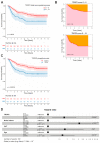TROP2 Represents a Negative Prognostic Factor in Colorectal Adenocarcinoma and Its Expression Is Associated with Features of Epithelial-Mesenchymal Transition and Invasiveness
- PMID: 36077674
- PMCID: PMC9454662
- DOI: 10.3390/cancers14174137
TROP2 Represents a Negative Prognostic Factor in Colorectal Adenocarcinoma and Its Expression Is Associated with Features of Epithelial-Mesenchymal Transition and Invasiveness
Abstract
Trophoblastic cell surface antigen 2 (TROP2) is a membrane glycoprotein overexpressed in many solid tumors with a poor prognosis, including intestinal neoplasms. In our study, we show that TROP2 is expressed in preneoplastic lesions, and its expression is maintained in most colorectal cancers (CRC). High TROP2 positivity correlated with lymph node metastases and poor tumor differentiation and was a negative prognostic factor. To investigate the role of TROP2 in intestinal tumors, we analyzed two mouse models with conditional disruption of the adenomatous polyposis coli (Apc) tumor-suppressor gene, human adenocarcinoma samples, patient-derived organoids, and TROP2-deficient tumor cells. We found that Trop2 is produced early after Apc inactivation and its expression is associated with the transcription of genes involved in epithelial-mesenchymal transition, the regulation of migration, invasiveness, and extracellular matrix remodeling. A functionally similar group of genes was also enriched in TROP2-positive cells from human CRC samples. To decipher the driving mechanism of TROP2 expression, we analyzed its promoter. In human cells, this promoter was activated by β-catenin and additionally by the Yes1-associated transcriptional regulator (YAP). The regulation of TROP2 expression by active YAP was verified by YAP knockdown in CRC cells. Our results suggest a possible link between aberrantly activated Wnt/β-catenin signaling, YAP, and TROP2 expression.
Keywords: APC; EMT; TACSTD2; WNT/β-catenin signaling; colorectal cancer; expression profiling; organoids.
Conflict of interest statement
The authors declare no conflict of interest.
Figures









References
Grants and funding
LinkOut - more resources
Full Text Sources
Molecular Biology Databases
Research Materials
Miscellaneous

